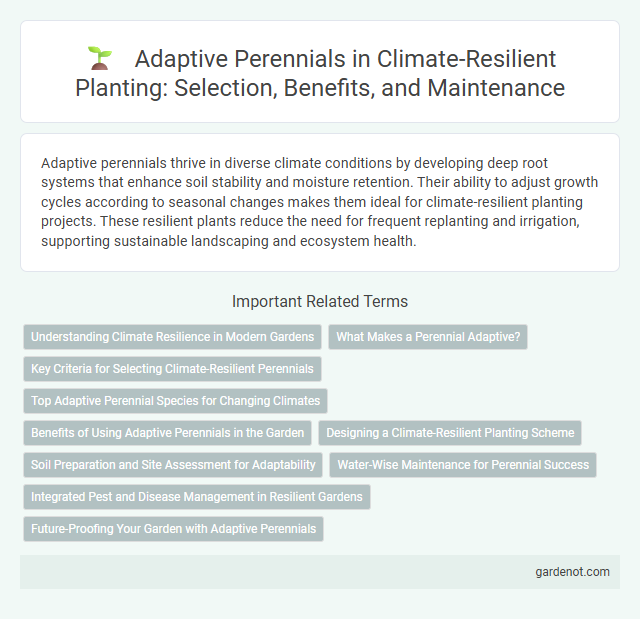Adaptive perennials thrive in diverse climate conditions by developing deep root systems that enhance soil stability and moisture retention. Their ability to adjust growth cycles according to seasonal changes makes them ideal for climate-resilient planting projects. These resilient plants reduce the need for frequent replanting and irrigation, supporting sustainable landscaping and ecosystem health.
Understanding Climate Resilience in Modern Gardens
Adaptive perennials exhibit remarkable climate resilience by withstanding extreme weather conditions such as drought, heat, and frost, making them ideal for modern gardens facing unpredictable climates. These plants possess deep root systems and flexible growth habits that enable efficient water use and recovery from environmental stress. Incorporating adaptive perennials into landscapes not only enhances garden sustainability but also supports biodiversity and soil health under shifting climatic conditions.
What Makes a Perennial Adaptive?
Adaptive perennials possess traits such as deep root systems, drought tolerance, and the ability to thrive in diverse soil conditions, enabling them to withstand climate variability. Their genetic diversity and phenotypic plasticity allow for rapid adjustment to changing temperature and precipitation patterns. These characteristics enhance ecosystem resilience and support sustainable agricultural practices in climate-stressed environments.
Key Criteria for Selecting Climate-Resilient Perennials
Selecting climate-resilient perennials hinges on key criteria such as drought tolerance, soil adaptability, and resistance to temperature extremes, ensuring long-term survival amid changing climatic conditions. Root system architecture and phenological flexibility are critical for maximizing water uptake and adjusting growth cycles to variable weather patterns. Biodiversity benefits increase when perennials are chosen for their ability to support pollinators and improve ecosystem resilience.
Top Adaptive Perennial Species for Changing Climates
Top adaptive perennial species such as switchgrass (Panicum virgatum), big bluestem (Andropogon gerardii), and eastern gamagrass (Tripsacum dactyloides) exhibit strong resilience to drought, heat, and soil variability, making them ideal for climate-resilient planting. These perennials improve soil health through extensive root systems, enhance carbon sequestration, and support biodiversity in shifting ecosystems. Selecting species with proven adaptability to local climate stressors is essential for sustaining agricultural productivity and ecosystem stability amid changing environmental conditions.
Benefits of Using Adaptive Perennials in the Garden
Adaptive perennials enhance garden resilience by withstanding extreme weather conditions such as drought, heat, and frost, ensuring long-term plant survival and stability. Their deep root systems improve soil structure, promote water retention, and reduce erosion, contributing to a healthier garden ecosystem. Incorporating adaptive perennials increases biodiversity, supports pollinators, and reduces the need for frequent watering and chemical inputs, making gardens more sustainable and climate-resilient.
Designing a Climate-Resilient Planting Scheme
Adaptive perennials enhance climate resilience by offering deep root systems that improve soil stability and water retention in planting schemes. Selecting species with proven drought tolerance and seasonal adaptability ensures sustained growth despite changing weather patterns. Integrating diverse perennials optimizes ecosystem functions, supports biodiversity, and mitigates the impacts of extreme climate events.
Soil Preparation and Site Assessment for Adaptability
Adaptive perennial planting requires thorough site assessment to evaluate soil texture, pH, drainage, and nutrient levels, ensuring optimal adaptability to local climate conditions. Soil preparation involves organic matter incorporation and erosion control measures, enhancing soil structure and moisture retention critical for perennial root development. Selecting appropriate adaptive species combined with tailored site-specific soil management maximizes resilience against climate variability and extreme weather events.
Water-Wise Maintenance for Perennial Success
Adaptive perennial plants enhance climate resilience by thriving with minimal water inputs, significantly reducing irrigation needs. Their deep root systems improve soil moisture retention and promote efficient water use, essential for sustainable landscaping in drought-prone areas. Implementing water-wise maintenance practices like mulching and drip irrigation further supports perennial health and conserves water resources.
Integrated Pest and Disease Management in Resilient Gardens
Adaptive perennials play a crucial role in integrated pest and disease management within climate-resilient gardens by enhancing natural pest control and reducing chemical inputs. These plants support beneficial insects and resilient soil microbiomes, creating a balanced ecosystem that suppresses pest outbreaks and disease proliferation. Incorporating adaptive perennial species tailored to local climates ensures long-term garden health and sustainability under changing environmental conditions.
Future-Proofing Your Garden with Adaptive Perennials
Adaptive perennials enhance climate resilience by surviving extreme weather patterns and requiring minimal water, reducing garden maintenance and resource use. Planting drought-tolerant species like lavender, coneflower, and sedum supports soil health and biodiversity while ensuring vibrant blooms year after year. Selecting regionally adapted perennials future-proofs your garden against climate variability through sustained growth and ecological balance.
Adaptive perennial Infographic

 gardenot.com
gardenot.com